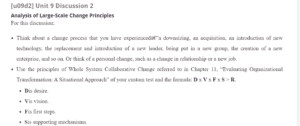Change Management
The process of change management is crucial to organizational success. For an organization to be sustainable, it must undergo changes that align with its changing business environment (Wagner et al., 2012). I have been a part of an organization that had to introduce a new product line to increase the company’s competitive advantage in the market. However, this product’s implementation failed, mainly because of employee resistance. This resistance was primarily because of the lack of some of the factors that would have led to successful change.
Do you need an authentic copy of “Change Management essay”? Get in touch with us.
For change to be successful, the employees must desire change. The employees should have noticed the need for change and yearned for a situation where the change has been implemented (Bartlett, 2012). In this organization, most employees were unaware of the change until the implementation phase. They had no desire to participate in the change because they did not understand it. Change requires a clear vision for employees to participate. In this change, the management communicated the vision. However, the vision was not shared by the employees. There was a lack of commitment to participate in the implementation of the change. The first steps taken to implement the change were successful. Leadership guidance helped the employees to get on board relatively quickly. However, the supporting mechanisms were limited. Employees were not rewarded for their effort or motivated in any way. This led to the resistance that eventually led to project failure.
As a consultant of this organization, I recommend that the management engages in better planning for change. This change was headed to failure when the management failed to build a desire for change. In future change processes, the management should try to use communication as a strategy for communicating a need for change and building the employees’ desire to participate in the change process.
Similar Post: 5S Program
References
Bartlett, T. (2012).Mixed voices and collaborative change: Contextualising positive discourse analysis. Routledge.
Wagner, T., Kegan, R., Lahey, L. L., Lemons, R. W., Garnier, J., Helsing, D., … & Rasmussen, H. T. (2012). Change leadership: A practical guide to transforming our schools. John Wiley & Sons.
ORDER A PLAGIARISM-FREE PAPER HERE
We’ll write everything from scratch
Question
[u09d2] Unit 9 Discussion 2
Analysis of Large-Scale Change Principles
For this discussion:

Change Management
- Think about a change process that you have experienced— a downsizing, an acquisition, an introduction of new technology, the replacement and introduction of a new leader, being put in a new group, creating a new enterprise, and so on. Or think of a personal change, such as a change in relationship or a new job.
- Use the Whole System Collaborative Change principles referred to in Chapter 11, “Evaluating Organizational Transformation: A Situational Approach,” of your custom test and the formula: D x V x F x S > R.
- This desire.
- Vis vision.
- Fis first steps.
- Sis supporting mechanisms.
- Ris resistance.
- Write a one-page analysis describing D, V, F, S, and R, and describe how these factors helped create change or describe what was missing that made the change difficult. Set the paper to hit topics listed under the distinguished column in the discussion participation guide below.
- Imagine you are the consultant and make recommendations about what was needed to overcome the missing element.
Resources
DISCUSSION PARTICIPATION SCORING GUIDE
Due Date: Weekly.
Percentage of Course Grade: 30%.
Due Date: Weekly.
Percentage of Course Grade: 30%.
| DISCUSSION PARTICIPATION GRADING RUBRIC | ||||
| Criteria | Non-performance | Basic | Proficient | Distinguished |
| Applies relevant course concepts, theories, or materials correctly. | Does not explain relevant course concepts, theories, or materials. | Explains relevant course concepts, theories, or materials. | Applies relevant course concepts, theories, or materials correctly. | Use examples or supporting evidence to analyze course concepts, theories, or materials correctly. |
| Collaborates with fellow learners, relating the discussion to relevant course concepts. | Does not collaborate with fellow learners. | Collaborates with fellow learners without relating the discussion to the relevant course concepts. | Collaborates with fellow learners, relating the discussion to relevant course concepts. | Collaborates with fellow learners, relating the discussion to relevant course concepts and extending the dialogue. |
| Applies relevant professional, personal, or other real-world experiences. | Does not contribute professional, personal, or other real-world experiences. | Contributes professional, personal, or other real-world experiences but lacks relevance. | Applies relevant professional, personal, or other real-world experiences. | Applies relevant professional, personal, or real-world experiences to extend the dialogue. |


